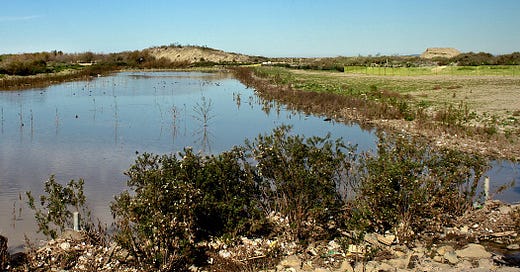EPA proposes solutions for Tijuana trans-border sewage
The federal agency seeks comments on draft addressing the problem that fouls southern California beaches and wetlands
For those of us who live in San Diego County, the warnings have become an expected part of summer: signs at the beaches announcing closures because of sewage contamination.
The problem starts south of the border. Tijuana treats its sewage and discharges it to the Pacific Ocean. Because of problems with their infrastructure, much of that sewage remains improperly treated or untreated altogether. The currents off the coast flow north during the summer, bringing that tainted ocean water to beaches in the U.S. Imperial Beach, a mile or two north of the border, is hardest hit, although other beaches farther north can suffer as well.
The other sewage source is the Tijuana River. The river first flows south, from the U.S. into Mexico, then back north across the border again. During its flow through Tijuana, the river picks up sewage and trash. Recent testing of the Tijuana river water found fecal coliform bacteria and drug-resistant bacteria. The maquiladoras in Tijuana treat the river as an open sewer, as industry used to in the U.S. The same testing found benzene, cadmium, mercury, hexavalent chromium, medical waste, and even DDT, the pesticide that has been heavily restricted for decades in the United States.

Since 1999 a treatment plant north of the border, the South Bay International Wastewater Treatment Plant, treats about 25 million gallons of effluent a day from the Tijuana River, yet I’m told that the river pollution remains a problem.
This last week, the U.S. Environmental Protection Agency and U.S. Section of the International Boundary and Water Commission opened up comments on an Impact Statement for the newly proposed Comprehensive Infrastructure Solution that would address the sewage problem. Public information sessions are planned, and the EPA is accepting comments until August 1st of this year.
In brief, the EPA came up with ten projects to undergo feasibility studies. The projects would span the border, some in Tijuana, others north of the border. One would reduce the flow of sewage into the the Tijuana River in the first place. Another would possibly treat Tijuana sewage for reuse. Further, the EPA came up with three proposed overall actions: 1. maintain the status quo; 2. undertake some of the projects; 3. undertake all of the projects.
This problem has been around a while
Trans-border sewage has been a problem since the 1930s, when the population of Tijuana, burgeoning to 500, overburdened the capacity of a septic tank. At the time, even that amount of unwanted effluent was enough to “contaminate and thereby prohibit the sale of truck crops grown in the San Ysidro area of the United States,” according to records of the California Regional Water Control Board.1
Since the 1930s, the population of Tijuana has exploded. In 1950, it was still a smallish mid-sized city, with a population of 60,000. Today more than 2.2 million residents make their home in Tijuana. In the 1990s, it was estimated that less than half the population of the city had plumbing.2 My guess is that things haven’t changed much in the intervening decades. It’s been years since I was in Tijuana, but I used to be there often; I’ve even worked there, playing in a band. From what I recall, while not constant, the smell of sewage cropped up a lot.
Further complications for beachgoers and surfers
Complicating this picture further are developments north of the border. As mentioned above, the problem with the sewage can wind up closing beaches at the very southern end of California. The County of San Diego performs regular testing of the ocean water off the coast. If the tests find elevated levels of pollutants, they close the beaches.
The San Diego County Department of Environmental Health commenced a new testing protocol that it claims will deliver quicker and more accurate pollution results. Some, like Imperial Beach Mayor Serge Dedina, fear that the more accurate results might be too accurate, detecting pollution at levels that are safe for humans.
The old test relied on leaving samples of ocean water in culture and waiting as long as 18 to 24 hours to detect bacteria. The new test looks directly for bacterial DNA, no waiting required.
Since the new testing was implemented in May, the signs warning of polluted waters have been posted for several weeks in Imperial Beach and Coronado, another beach town just to the north. Previous summers have not known beach closures for that length.
Although the new testing seems safer, the motivation that some have to keep the old test or lower the standards is understandable. A great deal of the economy of the beach communities comes from tourists and locals visiting their beaches. Closed beaches can mean revenue losses for hotels, restaurants, and other businesses that rely on folks who want to jump and swim in the surf.
For more environmental science & news follow me on Twitter @EcoScripsit.
Seth Mydans, Special to The New,York Times 1990, U.S. and Mexico Take On a Joint Burden: Sewage, Late Edition (East Coast) edn, New York, N.Y.
Ibid





As we know, once government uses lesser standards for public health solutions some are bound to suffer. It’s best to always keep standards high. Let’s hope the city of Imperial Beach looks out for all its citizens and tourists.